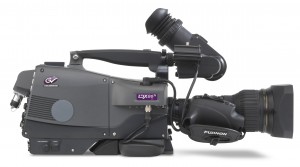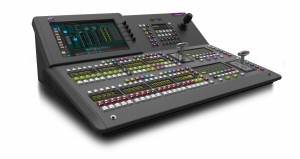SVG Europe Sit-Down: Grass Valley’s Jan-Pieter van Welsem on IP evolution, quality of training, and Cisco partnership
Grass Valley is confident that production over IP is now a proven solution and continues to build on that technology. The link up with Cisco is playing a major role in that progress. In fact, Vice-President of Sales and Marketing Jan-Pieter van Welsem finds the combination of the two companies’ solutions to be an ideal match. With that in mind, it made sense to start SVG Europe’s conversation with van Welsem with the subject of IP…
It is evident that IP is on everyone’s mind. What are your latest developments in that area?
Grass Valley continues to lead the transition to IP with a Broadcast Data Center model that enables a broadcast-centric IP plant designed with the affordability and efficiency of today’s IP networks and COTS switches, while leveraging the reliability, extensibility, functionality and familiarity of the SDI broadcast world. Our GV Convergent SDN control system controls and manages traffic through both IP switches and SDI routers, while controlling edge switching and orchestrating bandwidth with a design for the needs of broadcasters.
The Broadcast Data Center provides vertically-accurate switching through the GV Node Real-Time IP Processing and Routing Platform. Controlled by GV Convergent, GV Node’s real time, distributed routing and IP processing supports both IP and SDI workflows. Additionally, GV Convergent and GV Node provide other broadcast-centric benefits so that an IP infrastructure mimics traditional SDI workflow and processes.
We already have customers embracing our IP solutions to make their workflows vastly more efficient. Arena Television in the UK is currently deploying a fleet of IP-based OB trucks that feature Grass Valley technology to enable 4K UHD production. The first truck supports 32-camera productions and utilises end-to-end IP connectivity. The design is based around a Cisco IP switch, of which the core infrastructure is fibre, running 10GigE and where enabled, 40GigE. The architecture provides the ultimate production flexibility where existing baseband systems can seamlessly integrate with the new IP-enabled workflows, which is critical for a smooth IP transition.
Alongside IP use, what other changes have you noticed in sports production with respect to your products?
Live sports is a key market for our customers, and we continue to see them looking for ways to capture the action in ways that help them create a truly unique experience for their viewers. We venture to help them do this as efficiently as possible, and we’re constantly innovating to help them deliver on these goals. Our new LDX 86N Series camera enables users to capture content in native 4K. Built using Grass Valley’s newest UHD 2/3” imagers, the LDX 86N provides the best possible native 4K resolution in true 16:9 aspect ratio, using lenses intended for broadcast with no cropping or zooming effects. The camera gives broadcasters the advantage of selecting between the highest image resolution with native 4K or switching to native 3G/HD for all applications where uncompromised 3G/HD performance is required.
Our new GV Korona switcher offers the same robust feature set as our Kayenne and Karrera, but does so with a smaller, space-efficient control surface that is so important in sports environments. Available in 1 and 2 M/E (stripe) panels, GV Korona is packaged with the compact K-Frame S-series video processing engine, though it is compatible with all Grass Valley K-Frames for unlimited flexibility in video production. It supports multiple HD formats, and can easily be upgraded to 3G/4K with a software licence.
Furthermore, Grass Valley’s LDX Series is the only family of cameras with a direct IP interface on the camera itself, enabling broadcasters to connect LDX Series cameras directly to commercial-off-the-shelf (COTS) switches on an IP network. This allows the transporting the full camera protocol through an IP network to the XCU base stations connected to another COTS switch on the same IP network for remote production.
How do you see VR developing with regards to the sports market? What solutions can you offer?
There is a lot of talk about VR for sports production, and our solutions are ready to support the industry as it investigates this exciting new technology to improve the viewing experience and drive new revenue streams.
The Cloud is also occupying people’s minds. What is the future of hardware companies when it comes to an increasing use of software solutions?
Virtualisation is an increasingly important consideration in broadcast, as customers look to leverage the speed and flexibility of cloud-based solutions. At Grass Valley, we’re embracing this trend with solutions today that include playout, multiviewers and configurable control systems. The move to virtualise even more of a broadcast workflow is dependent on many factors — but the technologies developed by ‘hardware companies’, as you say, will be required to ensure the level of stability and quality upon which broadcasters rely.
With the increasing use of IT solutions, are the media colleges turning out engineers who understand both broadcast and IT technologies?
Colleges and universities are doing an excellent job today of preparing the next generation of broadcasters and media professionals for emerging technologies. With the ability to leverage proven IT technology to implement a powerful, efficient IP infrastructure for this market, young professionals are well prepared to drive the industry forward. As a founding member of AIMS, Grass Valley has been a leader in ensuring that the industry adheres to open standards so that customers can build the networks and facilities that directly address their needs.
What are the latest developments that have arisen from the partnership between Grass Valley and Cisco, especially with regards sports broadcasting?
The latest result of the partnership between Grass Valley and Cisco is a new bundled product offering featuring Cisco Switches, now available directly through Grass Valley. As part of an integrated commercial COTS IP approach, the Cisco Nexus® 9200 and 9300 kits provide the COTS IP network infrastructure, licences and support required for all of Grass Valley’s IP-enabled products. Not only do these solutions accelerate and ease installation and setup, they also ensure compatibility with Grass Valley’s IP Broadcast Data Center solutions.
Cisco’s IP fabric for media solution expands or replaces traditional baseband video routing in sports, live, news and content distribution applications with an IP-based infrastructure. When combined with Grass Valley’s IP-enabled cameras, servers, production switchers and other endpoint gear, it provides a tested solution for reliable audio, video and ancillary data flows over an IP network.
The Arena TV project referenced earlier is a great example of the type of solution that this partnership enables. Live Production over IP is now a proven solution that delivers, without a hitch, in the most critical, highly visible applications.
Where do you think we will be with HDR by the end of this year? Or should we be looking further ahead for significant take-up?
High Dynamic Range (HDR) capture, an expansion of the ratio between the lightest and darkest parts of the video image, is quickly gaining in popularity for its ability to capture any type of live action, even under the most severe lighting conditions, and deliver unrivalled picture quality, without forcing customers to change their existing camera hardware. Our LDX 86 Series cameras feature Xensium FT imagers which support the full 15 F-stops of dynamic range required for HDR. This means customers can easily upgrade to HDR functionality. For many broadcasters, HDR is seen as a relatively small investment that provides immediate visual benefits for the largest number of content consumers. Grass Valley supports Native HDR across its entire live production portfolio and we anticipate that customers will continue to investigate its benefits.
And finally, let’s ask that same question with regards to 4K? Will there be any significant developments by the end of this year?
Grass Valley offers a full line of 4K products that make it possible for customers to move into 4K production at their own pace. From cameras and switchers to replay, multiviewing and infrastructure, our portfolio is designed to deliver content in a format that addresses the preferences of the audience. Whether it is HD or 4K, or a mixture from project to project, customers can make investments today that will equip them for the future. From our standpoint, end-to-end 4K is fully supported—and we’re there for our customers regardless of the delivery or consumption method that takes the lead in 4K viewership.



